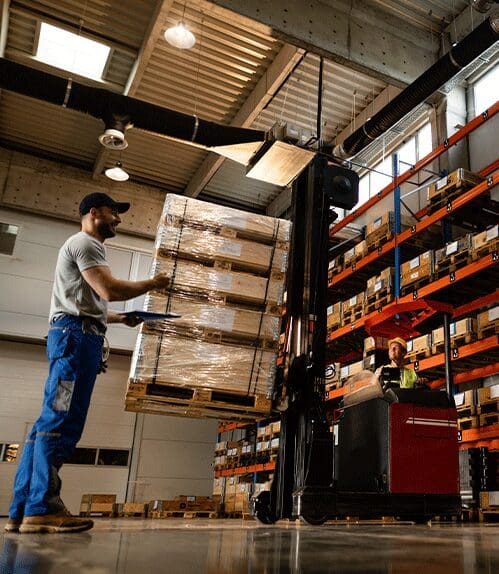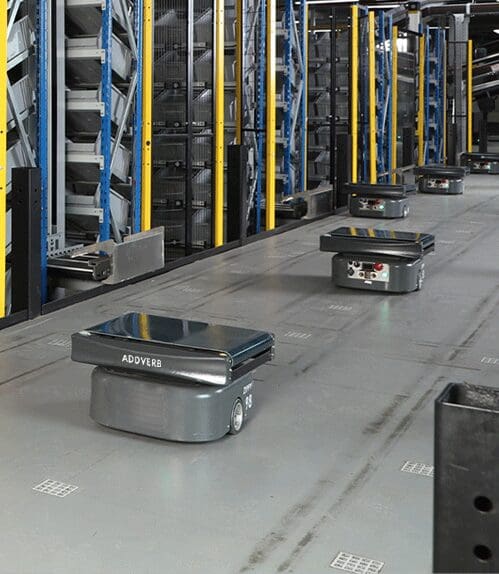Table of Contents
The logistics landscape has undergone a seismic shift with the advent of mega distribution centers. These colossal hubs, often spanning millions of square feet, are redefining how goods are stored, processed, and distributed. In an era where efficiency and speed are paramount, Mega DC are at the forefront, leveraging advanced technologies to streamline operations and meet the ever-growing demands of e-commerce and global supply chains.
The Growth of Mega Distribution Centers
The rise of e-commerce giants like Amazon, Alibaba, and Walmart has driven the need for larger, more efficient distribution centers. Mega DC, unlike traditional warehouses, are designed to handle vast quantities of goods, process high volumes of orders, and ensure rapid delivery. These centers are strategically located near major transportation hubs to optimize the flow of goods across regions and countries.
Discover how Addverb’s cutting-edge solutions transformed ITC’s mega warehouse operations! From increased efficiency to seamless automation.
Key Features of Mega Distribution Centers
Size and Capacity: DCs can be as large as 3 million square feet or more, housing millions of SKUs (Stock Keeping Units). This immense capacity allows for significant economies of scale.
Advanced Technology: Automated Storage and Retrieval Systems (ASRS), Autonomous Mobile Robots (AMRs), and sophisticated warehouse management systems (WMS) are integral to Mega DC operations. These technologies enhance accuracy, reduce labor costs, and increase throughput.
Strategic Location: Proximity to major highways, ports, and airports is critical. This reduces transit times and shipping costs, ensuring goods can be delivered quickly and efficiently.
Sustainability Initiatives: Many Mega DC are designed with sustainability in mind, incorporating energy-efficient systems, renewable energy sources, and green building practices to minimize their environmental impact.
Impact on Logistics
The emergence of Mega Distribution Centers has profound implications for the logistics industry:
Increased Efficiency: The integration of cutting-edge technology enables Mega DC to process orders faster and with greater accuracy. This translates to quicker turnaround times and more reliable delivery schedules.
Cost Reduction: By consolidating operations into a single, massive facility, companies can reduce overhead costs, lower transportation expenses, and achieve better economies of scale.
Enhanced Scalability: DCs provide the flexibility to scale operations up or down based on demand. This is particularly crucial during peak seasons or unexpected surges in orders.
Improved Inventory Management: Advanced inventory tracking systems allow for real-time visibility into stock levels, reducing the risk of overstocking or stockouts and ensuring optimal inventory turnover.
Job Creation and Workforce Transformation: While automation reduces the need for manual labor, MDCs also create new job opportunities in technology, maintenance, and management roles. Training and upskilling the workforce to handle these advanced systems is essential.
Challenges and Considerations
Despite their benefits, Mega Distribution centers are not without challenges:
High Initial Investment: The cost of building and equipping an Mega DC is substantial. Companies must carefully weigh the long-term benefits against the initial expenditure.
Complexity of Operations: Managing a facility of this scale requires sophisticated planning and coordination. Ensuring smooth operations across various departments and technologies is critical.
Regulatory and Compliance Issues: Mega DCs must adhere to stringent regulations regarding safety, labor practices, and environmental impact. Compliance can be complex and costly.
What Goes into a Mega Distribution Center
Mega Distribution Center, by its very nature, is the Mothership and should satisfy a variety of needs. Therefore, it is a multifaceted and multitasking entity that is designed to perform end-to-end logistics demands for any business. It should have the following attributes:
A large facility typically of an area around 400,000 Sq.ft. would qualify as a mega DC.
Designed to suit large inbound and outbound traffic at high throughput
Have a very good locational advantage and are capable of handling heavy truck traffic continuously
Must lend itself well to be connected to mini and mega markets to meet the demands. This will in turn make the mega DC a viable proposition
Fully automated material handling system, storage, and retrieval system linked with business ERP system on a real-time basis
All the above attributes will essentially mean having multiple subsystems that handle material movement within the premises in a seamlessly integrated manner.
Technology and Solutions to be built into a Mega DC
Mega DCs normally operate 24*7 and hence are ideal candidates for automation due to the continuity of service and running multiple tasks simultaneously to meet a high volume of operations.
A good approach would be to break the domains down to:
- Business needs in general.
- Structure of the mega DC – Does it serve as a Mother DC feeding cross-dock DCs to serve the needs of a mini distribution center.
- Transportation
- Geography – Locational aspects
Technology and automated material handling solutions are commonplace these days. They help in meeting all the demands – ease of operation, higher productivity per person deployed, unparalleled operational safety, and consistently very high throughputs and accuracy. A carefully designed combination of infrastructure, automated material handling solutions, and location will deliver a good value proposition to a business in smart supply chains.
Want to dive deeper into topics like this? Check out our other blogs for more insights and updates!
The Future of Mega Distribution Centers
As consumer expectations continue to evolve, MDCs will play an increasingly vital role in the logistics ecosystem. Innovations such as AI-driven analytics, drone deliveries, and blockchain for supply chain transparency are likely to further enhance the capabilities of these mega hubs. Companies that invest in MDCs and the associated technologies will be well-positioned to lead the charge in a competitive, fast-paced market.
Conclusion
Mega distribution centers represent a transformative development in logistics, offering unparalleled efficiency, scalability, and technological advancement. By embracing MDCs, companies can not only meet the demands of today’s consumers but also prepare for the challenges and opportunities of tomorrow. As the logistics landscape continues to evolve, the rise of MDCs stands as a testament to the industry’s commitment to innovation and excellence.

FAQ
What are Mega Distribution Centers (MDCs)?
MDCs are large-scale facilities designed to handle vast volumes of goods, serving as central hubs for receiving, storing, and distributing products across wide areas.
Why are MDCs becoming more popular?
MDCs offer economies of scale, improved inventory management, and enhanced logistics efficiency to meet the growing demands of e-commerce and fast delivery expectations.
How do MDCs impact logistics operations?
MDCs streamline supply chains by consolidating storage and distribution activities, leading to cost savings, faster order fulfillment, and better resource utilization.
What technologies support MDCs?
MDCs use automation technologies like Autonomous Mobile Robots (AMRs), Automated Storage and Retrieval Systems (ASRS), and advanced warehouse management software to optimize operations.
What are the benefits of AMRs and ASRS in MDCs?
AMRs and ASRS enhance efficiency by automating material handling and storage tasks, improving accuracy, reducing labor costs, and enabling higher storage density.
What challenges do companies face with MDC implementation? Challenges include high initial investment, integration complexity, and the need for skilled personnel to manage automated systems.
How do MDCs contribute to sustainability in logistics?
MDCs optimize transportation routes, reduce emissions, and use energy-efficient technologies, lowering environmental impact.
Founded in 2016, Addverb offers complete robotics solutions for warehouse and industrial automation, with a strong global presence through its subsidiaries worldwide. The company provides a range of in-house automation products, including Autonomous Mobile Robots, ASRS, and sorting technologies. It serves over 350+ clients, including well-known companies such as Coca-Cola, Amazon, and DHL.





